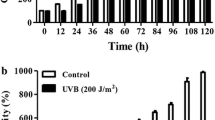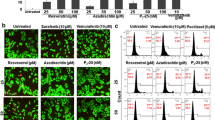Abstract
Mammalian ultraviolet (UV) radiation response is a gene induction cascade activated by several transcription factors, including NF-κB. Although NF-κB is induced by UV radiation, the signal transduction mechanism remains relatively unclear. In the present study, we show that UV-induced NF-κB activation is mediated by the activation of Ataxia telangiecia mutated (ATM) and protein kinase C (PKC). We also show that caffeine specifically inhibits UV-mediated NF-κB activation, but not TNFα-mediated NF-κB activation. In addition, our study shows that ATM, but not ATM-Rad3-related (ATR) or DNA-dependent protein kinase (DNA-PK) is involved in UV-induced NF-κB activation. Because SB203580 (a p38 MAPK inhibitor), or Calphostin C or rottlerin (PKC inhibitors) was able to inhibit UV-mediated NF-κB activation, we evaluated whether caffeine could inhibit p38 MAPK or PKC activity. Caffeine or rottlerin inhibited UV-induced phosphorylation of p38 MAPK, but not anisomycin-induced phosphorylation of p38 MAPK, suggesting that p38 MAPK is downstream of PKC. Additionally, caffeine could effectively inhibit UV-induced increases in PKC activity. Taken together, our study demonstrates that caffeine is a potent inhibitor of UV-induced NF-κB activation. Additionally, this inhibition occurs due to the inhibitory action of caffeine on ATM and PKC, resulting in the inhibition of p38 MAPK activation.




Similar content being viewed by others
References
Amos S, Martin PM, Polar GA, Parsons SJ, Hussaini IM (2005) Phorbol 12-myristate 13-acetate induces epidermal growth factor receptor transactivation via protein kinase Cdelta/c-Src pathways in glioblastoma cells. J Biol Chem 280:7729–7738
Baldwin AS Jr (1996) The NF-kappa B and I kappa B proteins: new discoveries and insights. Annu Rev Immunol 14:649–683
Basu S, Rosenzweig KR, Youmell M, Price BD (1998) The DNA-dependent protein kinase participates in the activation of NF kappa B following DNA damage. Biochem Biophys Res Commun 247:79–83
Bender K, Gottlicher M, Whiteside S, Rahmsdorf HJ, Herrlich P (1998) Sequential DNA damage-independent and -dependent activation of NF-kappaB by UV. EMBO J 17:5170–5181
Bode AM, Dong Z (2005) Signal transduction pathways in cancer development and as targets for cancer prevention. Prog Nucleic Acid Res Mol Biol 79:237–297
Bryant HE, Helleday T (2006) Inhibition of poly (ADP-ribose) polymerase activates ATM which is required for subsequent homologous recombination repair. Nucleic Acids Res 34:1685–1691
Chen CY, Faller DV (1999) Selective inhibition of protein kinase C isozymes by Fas ligation. J Biol Chem 274:15320–15328
Cummings R, Zhao Y, Jacoby D, Spannhake EW, Ohba M, Garcia JG, Watkins T, He D, Saatian B, Natarajan V (2004) Protein kinase Cdelta mediates lysophosphatidic acid-induced NF-kappaB activation and interleukin-8 secretion in human bronchial epithelial cells. J Biol Chem 279:41085–41094
Das KC, Dashnamoorthy R (2004) Hyperoxia activates the ATR-Chk1 pathway and phosphorylates p53 at multiple sites. Am J Physiol Lung Cell Mol Physiol 286:L87–L97
Das KC, White CW (1997) Activation of NF-kappaB by antineoplastic agents. Role of protein kinase C. J Biol Chem 272:14914–14920
DeFrank JS, Tang W, Powell SN (1996) p53-null cells are more sensitive to ultraviolet light only in the presence of caffeine. Cancer Res 56:5365–5368
Hoffmann A, Levchenko A, Scott ML, Baltimore D (2002) The IkappaB-NF-kappaB signaling module: temporal control and selective gene activation. Science 298:1241–1245
Huang C, Li J, Chen N, Ma W, Bowden GT, Dong Z (2000) Inhibition of atypical PKC blocks ultraviolet-induced AP-1 activation by specifically inhibiting ERKs activation. Mol Carcinog 27:65–75
Kato T Jr, Delhase M, Hoffmann A, Karin M (2003) CK2 is a C-terminal IkappaB Kinase responsible for NF-kappaB activation during the UV response. Mol Cell 12:829–839
Koo SW, Hirakawa S, Fujii S, Kawasumi M, Nghiem P (2007) Protection from photodamage by topical application of caffeine after ultraviolet irradiation. Br J Dermatol 156:957–964
Lee HS, Kim BC, Hong HK, Kim YS (1999) LDL stimulates collagen mRNA synthesis in mesangial cells through induction of PKC and TGF-beta expression. Am J Physiol 277:F369–F376
Li N, Banin S, Ouyang H, Li GC, Courtois G, Shiloh Y, Karin M, Rotman G (2001) ATM is required for IkappaB kinase (IKKk) activation in response to DNA double strand breaks. J Biol Chem 276:8898–8903
Li B, Wang X, Rasheed N, Hu Y, Boast S, Ishii T, Nakayama K, Nakayama KI, Goff SP (2004) Distinct roles of c-Abl and Atm in oxidative stress response are mediated by protein kinase C delta. Genes Dev 18:1824–1837
Lindskog M, Svenningsson P, Pozzi L, Kim Y, Fienberg AA, Bibb JA, Fredholm BB, Nairn AC, Greengard P, Fisone G (2002) Involvement of DARPP-32 phosphorylation in the stimulant action of caffeine. Nature 418:774–778
Lu YP, Lou YR, Xie JG, Peng QY, Liao J, Yang CS, Huang MT, Conney AH (2002) Topical applications of caffeine or (−)-epigallocatechin gallate (EGCG) inhibit carcinogenesis and selectively increase apoptosis in UVB-induced skin tumors in mice. Proc Natl Acad Sci USA 99:12455–12460
Meffert MK, Baltimore D (2005) Physiological functions for brain NF-kappaB. Trends Neurosci 28:37–43
Nakai-Murakami C, Shimura M, Kinomoto M, Takizawa Y, Tokunaga K, Taguchi T, Hoshino S, Miyagawa K, Sata T, Kurumizaka H, Yuo A, Ishizaka Y (2007) HIV-1 Vpr induces ATM-dependent cellular signal with enhanced homologous recombination. Oncogene 26:477–486
Perez P, Page A, Jorcano JL (2000) Role of phosphorylated p50-NF-kappaB in the ultraviolet response of mouse skin. Mol Carcinog 27:272–279
Pomerantz JL, Baltimore D (2002) Two pathways to NF-kappaB. Mol Cell 10:693–695
Poyet JL, Srinivasula SM, Lin JH, Fernandes-Alnemri T, Yamaoka S, Tsichlis PN, Alnemri ES (2000) Activation of the Ikappa B kinases by RIP via IKKgamma /NEMO-mediated oligomerization. J Biol Chem 275:37966–37977
Qin JZ, Chaturvedi V, Denning MF, Choubey D, Diaz MO, Nickoloff BJ (1999) Role of NF-kappaB in the apoptotic-resistant phenotype of keratinocytes. J Biol Chem 274:37957–37964
Saksena S, Gill RK, Tyagi S, Alrefai WA, Sarwar Z, Ramaswamy K, Dudeja PK (2005) Involvement of c-Src and protein kinase C delta in the inhibition of Cl(-)/OH- exchange activity in Caco-2 cells by serotonin. J Biol Chem 280:11859–11868
Sarkaria JN, Busby EC, Tibbetts RS, Roos P, Taya Y, Karnitz LM, Abraham RT (1999) Inhibition of ATM and ATR kinase activities by the radiosensitizing agent, caffeine. Cancer Res 59:4375–4382
Shafer SH, Phelps SH, Williams CL (1998) Reduced DNA synthesis and cell viability in small cell lung carcinoma by treatment with cyclic AMP phosphodiesterase inhibitors. Biochem Pharmacol 56:1229–1236
Sodhi A, Sethi G (2005) Role of protein kinase Cdelta in UV-B-induced apoptosis of macrophages in vitro. Cell Signal 17:377–383
Stiff T, Walker SA, Cerosaletti K, Goodarzi AA, Petermann E, Concannon P, O’Driscoll M, Jeggo PA (2006) ATR-dependent phosphorylation and activation of ATM in response to UV treatment or replication fork stalling. EMBO J 25:5775–5782
Tamaoki T, Nomoto H, Takahashi I, Kato Y, Morimoto M, Tomita F (1986) Staurosporine, a potent inhibitor of phospholipid/Ca++dependent protein kinase. Biochem Biophys Res Commun 135:397–402
Tanaka Y, Gavrielides MV, Mitsuuchi Y, Fujii T, Kazanietz MG (2003) Protein kinase C promotes apoptosis in LNCaP prostate cancer cells through activation of p38 MAPK and inhibition of the Akt survival pathway. J Biol Chem 278:33753–33762
van Hogerlinden M, Rozell BL, Ahrlund-Richter L, Toftgard R (1999) Squamous cell carcinomas and increased apoptosis in skin with inhibited Rel/nuclear factor-kappaB signaling. Cancer Res 59:3299–3303
Wang L, Lu L (2007) Pathway-specific effect of caffeine on protection against UV irradiation-induced apoptosis in corneal epithelial cells. Invest Ophthalmol Vis Sci 48:652–660
Wang CY, Cusack JC Jr, Liu R, Baldwin AS Jr (1999) Control of inducible chemoresistance: enhanced anti-tumor therapy through increased apoptosis by inhibition of NF-kappaB. Nat Med 5:412–417
Wang L, Dai W, Lu L (2005) Ultraviolet irradiation-induced K(+) channel activity involving p53 activation in corneal epithelial cells. Oncogene 24:3020–3027
Wu S, Tan M, Hu Y, Wang JL, Scheuner D, Kaufman RJ (2004) Ultraviolet light activates NFkappaB through translational inhibition of IkappaBalpha synthesis. J Biol Chem 279:34898–34902
Acknowledgments
This study was supported in part by research project grant from the American Cancer Society (KCD) and HL 071558 from the NIH (KCD). The authors also acknowledge the generous contribution of ATR plasmids by Dr Karlene Cimprich at Stanford University.
Author information
Authors and Affiliations
Corresponding author
Rights and permissions
About this article
Cite this article
Ravi, D., Muniyappa, H. & Das, K.C. Caffeine inhibits UV-mediated NF-κB activation in A2058 melanoma cells: an ATM-PKCδ-p38 MAPK-dependent mechanism. Mol Cell Biochem 308, 193–200 (2008). https://doi.org/10.1007/s11010-007-9628-x
Received:
Accepted:
Published:
Issue Date:
DOI: https://doi.org/10.1007/s11010-007-9628-x




